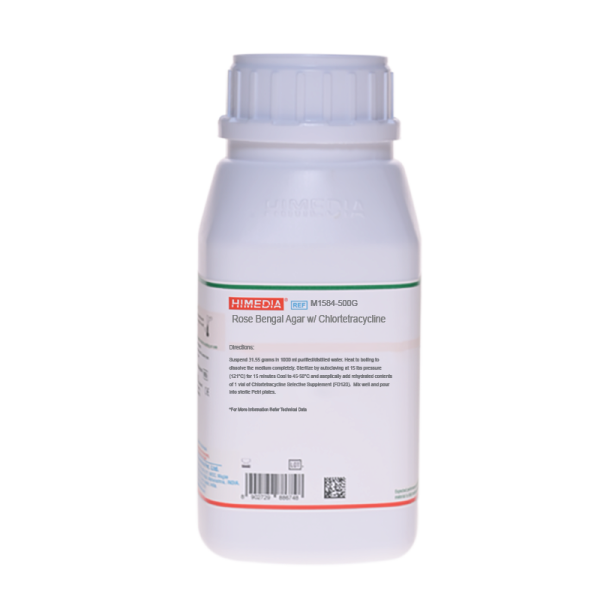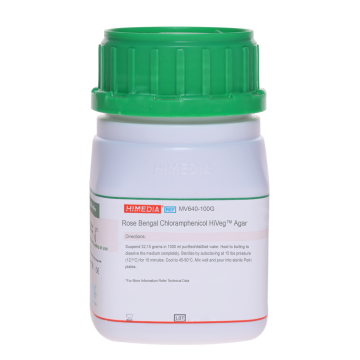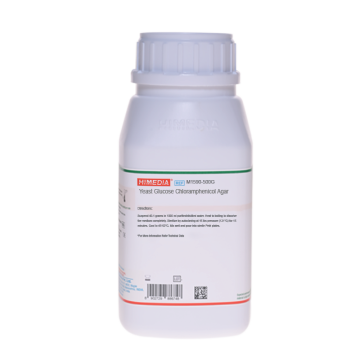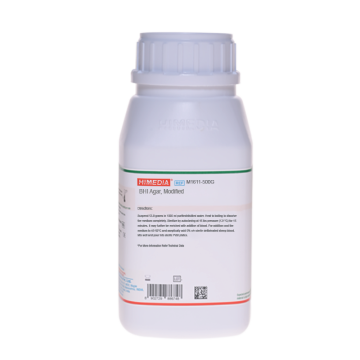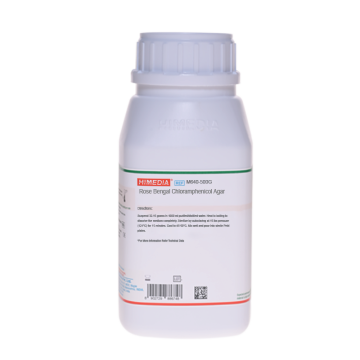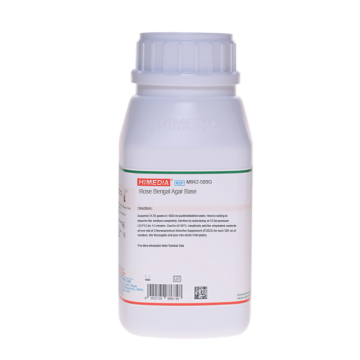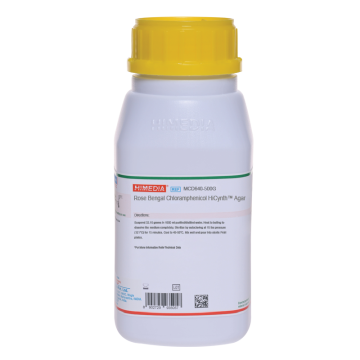 Your enquiry has been submitted
Your enquiry has been submitted
Rose Bengal Agar w/ Chlortetracycline
Rose Bengal Agar w/ Chlortetracycline is recommended for the selective isolation and enumeration of yeasts and moulds from environmental materials and foodstuffs.
Composition**
| Ingredients | Gms / Litre |
|---|---|
| Peptone, special | 5.000 |
| Dextrose | 10.000 |
| Monopotassium phosphate | 1.000 |
| Magnesium sulphate | 0.500 |
| Rose bengal | 0.050 |
| Agar | 15.000 |
Final pH ( at 25°C): 7.2±0.2
**Formula adjusted, standardized to suit performance parameters
Directions
Suspend 31.55 grams in 1000 ml distilled water. Heat to boiling to dissolve the medium completely. Sterilize by autoclaving at 15 lbs pressure (121°C) for 15 minutes. Cool to 45°C and aseptically add the rehydrated contents of 1 vial of Chlortetracycline Selective Supplement (FD120) to the medium. Mix thoroughly and pour into sterile Petri plates.
Principle And Interpretation
The use of media with an acid pH that selectively inhibits the growth of bacteria and thereby promotes the growth of fungi has been widely employed (1,2,3). A number of investigators have reported, however, that acidified media may actually inhibit fungal growth (4,5), fail to completely inhibit bacterial growth (4) and have little effect in restricting the size of mold colonies (6) Smith and Dawson (7) used rose bengal in a neutral pH medium for the selective isolation of fungi from soil samples. Chloramphenicol, streptomycin, oxytetracycline and chlortetracycline have been used for the improved, selective isolation and enumeration of yeasts and molds from soil, sewage and foodstuffs (5,8-11).
Rose Bengal Agar Base is a modification of the Rose Bengal Chlortetracycline Agar formula of Jarvis (9). Instead of chlortetracycline, chloramphenicol is employed in this medium as a selective supplement. Of the antibiotics most frequently employed in media of neutral pH, Chloramphenicol is recommended because of its heat stability and broad antibacterial spectrum (12). Rose Bengal Agar media are recommended in standard methods for the enumeration of yeasts and molds from foodstuffs and water. (12-14).
Peptone special provides the carbon and nitrogen sources required for good growth of a wide variety of organisms. Dextrose is an energy source. Monopotassium phosphate provides buffering capability. Magnesium sulfate provides necessary trace elements. Rose bengal is included as a selective agent that inhibits bacterial growth and restricts the size and height of colonies of the more rapidly growing molds. The restriction in growth of molds aids in the isolation of slow-growing fungi by preventing overgrowth by more rapidly growing species. Rose bengal is taken up by yeast and mold colonies, thereby facilitating their recognition and enumeration. Chlortetracycline Selective Supplement (FD120) is an antimicrobic supplement containing Chlortetracycline, which inhibits bacteria.
Due to the selective properties of this medium and the type of specimen being cultured, some strains of fungi may grow poorly or fail to grow on the complete medium; similarly, some strains of bacteria may also not inhibited or only partially inhibited.
Care should be taken not to expose this medium to light, since photodegradation of rose bengal yields compounds that are toxic to fungi (13, 15).
Quality Control
Appearance: Light yellow to pink homogeneous free flowing powder
Gelling: Firm, comparable with 1.5% Agar gel
Colour and Clarity of prepared medium: Deep pink coloured clear to very slightly opalescent gel forms in Petri plates
Reaction: Reaction of 3.16% w/v aqueous solution at 25°C. pH : 7.2±0.2
pH: 7.00-7.40
Cultural Response
M1584: Cultural characteristics observed after an incubation at 25°C for 5 days with added Chlortetracycline Selective Supplement(FD120).
| Organism | Growth |
|---|---|
| *Aspergillus brasiliensis ATCC 16404 | good-luxuriant |
| Bacillus subtilis ATCC 6633 | inhibited |
| Cladosporium cladosporioides ATCC 45534 | good-luxuriant |
| Escherichia coli ATCC 25922 | inhibited |
| Enterococcus faecalis ATCC 29212 | inhibited |
| Mucor racemosus ATCC 42647 | good-luxuriant |
| Pencillium notatum ATCC 10108 | good-luxuriant |
| Saccharomyces cerevisiae ATCC 9763 | good-luxuriant |
*Key: Formerly known as Aspergillus niger ATCC 16404
Storage and Shelf Life
Store below 30°C in tightly closed container and the prepared medium at 2 - 8°C. Use before expiry date on the label.
Reference
- Koburger. 1976. In Speck (ed.), Compendium of methods for the microbiological examination of foods. American Public Health Association, Washington, D.C.
- Mossel, Visser and Mengerink. 1962. Lab Practice 11:109.
- Waksman. 1922. J. Bacteriol. 7:339.
- Koburger. 1972. J. Milk Food Technol. 35:659.
- Martin. 1950. Soil Sci. 69:215.
- Tyner. 1944. Soil Sci. 57:271.
- Smith and Dawson. 1944. Soil Sci. 58:467.
- Cooke. 1954. Antibiot. and Chemother. 4:657.
- Jarvis. 1973. J. Appl. Bacteriol. 36:723.
- Overcast and Weakley. 1969. J. Milk Technol. 32:442. Papavizas and Davey. 1959. Soil Sci. 88:112.
- Marshall (ed.). 1993. Standard methods for the examination of dairy products, 16th ed. American Public Health Association, Washington, D.C.
- Beuchat and Cousin. 2001. In Downes and Ito (ed.), Compendium of methods for the microbiological examination of foods, 4th ed. American Public Health Association, Washington, D.C.
- Clesceri, Greenberg and Eaton (ed.). 1998. Standard methods for the examination of water and wastewater, 20th ed. American Public Health Association, Washington, D.C.
- Banks, Board and Paton. 1985. Lett. Appl. Microbiol. 1:7.
| Product Name | Rose Bengal Agar w/ Chlortetracycline |
|---|---|
| SKU | M1584 |
| Product Type | Regular |
| Physical Form | Powder |
| Origin | Animal |
| Packaging type | HDPE |
| References | 1. Koburger. 197 |
| Customized Product Available | No |



